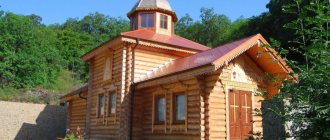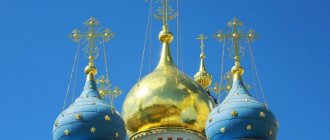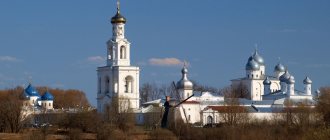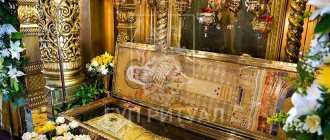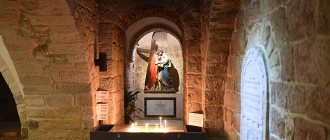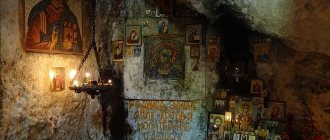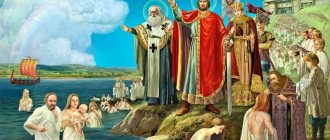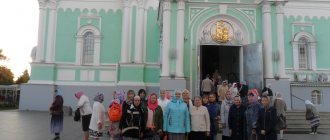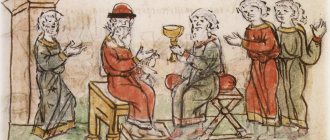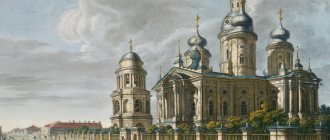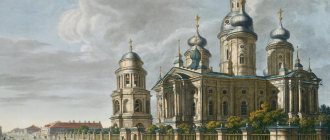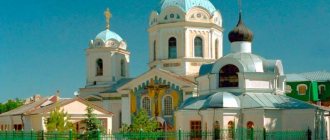History of the Assumption Cathedral
The main temple from the times of Vladimir-Suzdal Rus', in which the Moscow and Vladimir princes were married, is included in the list of UNESCO World Heritage Sites. This unique monument of the 12th century, which preserves original works by Andrei Rublev, is now a state museum-reserve.
The original temple 1158-1169
The Assumption Cathedral in Vladimir was built under Andrei Bogolyubsky, who dreamed of making it the main temple of Rus'. The church was erected not only by craftsmen from all Russian lands, but also by foreigners. The German builders were sent personally by Frederick Barbarossa. Specialists in bricklaying arrived from Kyiv, masters of white stone technology from the Dnieper region, and gilders from Greece and Galich. The location was chosen in the southern part of the city, on Klyazma.
Construction began in 1158, April 5th. The limestone building, decorated with white stone carvings, rose 5 meters higher than the St. Sophia Church in Kyiv. By 1160 the church building was completely rebuilt, and in 1161 it was painted. A quadruple covered with sheets of gilded copper rushed upward. The height of the central chapter was 32.3 meters. Entrance portals were built on three sides, the facade was decorated with complex pilasters and horizontally divided into two tiers by an arched frieze.
Those who got inside compared the magnificence of the cathedral with Solomon's Temple in Jerusalem. Gold and silver chandeliers reflected in the mosaic tiles that covered the floor. They were made of copper and colored majolica. The vaults and walls of the temple were painted with frescoes, and above the altar there was a platform for reading sermons, made of gold and silver.
Figure 1. Initial view of the Assumption Cathedral in Vladimir
Reconstruction of the cathedral in 1186-1189
In 1185, there was a fire in the city, and the Assumption Cathedral was seriously damaged. The architects restored the building, strengthening it with pylons and surrounding it with a second row of stone walls. The new "case" on the south, north and west sides was attached using arches. In addition to the resulting side galleries, the area of the altar was increased, the cathedral became more spacious (30.8 x 30 m) and had five aisles.
The restoration was carried out for 4 years by Andrei Bogolyubsky’s younger brother, Prince Vsevolod, nicknamed the Big Nest. The year of creation of the cathedral is considered to be 1158, but both brothers are buried in the northern gallery, who are revered as the creators of the shrine.
Further history of the cathedral
The long-suffering temple endured the hardships of the Mongol-Tatar invasion. The events are known when Batu, after the capture of Ryazan, rushed to Vladimir. This happened in 1238. Residents put up heroic resistance to the troops of the Tatar Khan, but were unable to hold the city. The family of Bishop Mitrofan, Princess Agafya Vsevolodovna and numerous defenders took refuge in the Assumption Cathedral. Batu gave the order to set fire to the cathedral, covering it with logs. The people inside suffered martyrdom, suffocating in the smoke.
The temple in Vladimir survived, but the walls and especially the painting were seriously damaged. Holy relics were looted and destroyed. The restoration of churches and the greatness of Rus' began after the victory on the Kulikovo Field. Prince Vasily, the son of Dmitry Donskoy, in 1408 invited two famous masters - Daniil Cherny and Andrei Rublev, who again painted the walls of the cathedral with frescoes.
In the 2nd half of the 18th century. Vladimir was visited by Catherine II, who allocated money for the renovation of the cathedral. 14 thousand rubles were spent on the iconostasis, made in the Baroque style. During the 18th–19th centuries. The appearance of the temple also underwent major changes. A bell tower with a gilded spire was built, which was connected to the cathedral by a chapel in honor of St. George the Victorious.
At the end of the XIX–XX centuries. A scientific restoration was carried out in the cathedral, as a result of which Rublev's frescoes were restored, the domes were gilded, and the white stone was cleaned. The last time the work was carried out was in the 70-80s. XX century.
Places of spiritual power in the Vladimir region
Vladimir is the spiritual center of Russia. It was from here that the capital was moved to Moscow, so all the power and glory of the Russian people begins here.
Today, not a single tourist or pilgrim bypasses the Vladimir lands, and this is also thanks to the activities of Governor Svetlana Orlova.
Tourists are surprised to learn that there are so many amazing things here, close to Moscow. Monuments of white stone architecture were built here, which are included in the UNESCO World Heritage List. Many world-famous Orthodox saints lived in our area.
The head of the pilgrimage service of the Vladimir diocese, Archpriest Anatoly Szegeda and his deputy Maria Fedotova told me about five places of spiritual power in our land.
The Church of the Intercession on the Nerl is a visiting card of Russia. One of the most famous temples in the world. This year marks 25 years since this white stone miracle was included in the UNESCO World Heritage List. Thousands of tourists from all over the world come to see it.
The architectural monument has never been rebuilt, despite the fact that it is more than 850 years old.
This has preserved its uniqueness.
The temple was built by Andrei Bogolyubsky in honor of the feast of the Intercession of the Blessed Virgin Mary. The throne in the church is consecrated. Worship services are held there. Next to the white stone cathedral there is another temple - the Three Saints.
— Two churches are already a bishop’s courtyard,
- says Maria.
— The preparatory stage before this place becomes a monastery.
To get to the temple, you need to walk one and a half kilometers along the famous Bogolyubovsky Meadow.
Like any self-respecting Vladimir resident, I visited the “Pearl of Holy Rus'” (as the Church of the Intercession on the Nerl is usually called). I want to say that the distance is absolutely not felt. Moreover, I couldn’t even believe that I had walked three kilometers, considering the way there and back.
- This is true
, - Maria supports me.
– If a person comes with certain thoughts, he walks the road easily and does not get tired.
In the Church of the Intercession on the Nerl, a special atmosphere is felt, different from other temples. There is some special peace and quiet there. The parishioners ask for intercession, for the Protection, so that the Mother of God, as our loving mother, would shelter us from all slander, help us and protect us. The Church of the Intercession on the Nerl is a place of solitary prayer. Andrei Bogolyubsky specifically ordered the construction of this temple behind the city. Legend has it that the prince erected the Temple of the Intercession on the Nerl in memory of his son Izyaslav, who died in a battle with the Volga Bulgarians.
The church stands at the confluence of the Nerl and Klyazma rivers as a sign of the joint reign of the Vladimir and Suzdal lands.
Deposition of Robe Monastery in Suzdal
The monastery is notable for its huge bell tower - 72 meters high. The highest point of the city. As local residents say, not going up to the Venerable Belfry and not looking at the panorama of the city is the same as not visiting Suzdal.
The monastery was founded at the beginning of the 13th century. The main shrine here is the Deposition of Robe Cathedral.
The most outstanding nun of the monastery is considered to be the Venerable Euphrosyne, the daughter of Prince Mikhail of Chernigov.
Young Euphrosyne was going to her own wedding in Suzdal. According to one version, she was supposed to marry Alexander Nevsky’s brother, according to another, to a Suzdal boyar. On the way, the princess learned that her fiancé had died. Upon arrival in the city, the girl decided to go to the Deposition of Robe Monastery.
— During her lifetime, through the prayers of Mother Euphrosyne, many miracles were performed
, - Maria continues to tell.
– During the Tatar-Mongol invasion, the city was burned with the exception of the Robbery Monastery.
The monastery was engulfed in thick fog, and the enemies did not notice it. During these difficult years, people from all over Rus' went to righteous Euphrosyne for advice. Mother received everyone. She had the gift of insight.
The nun predicted the death of her father in the Golden Horde. Later his own demise.
During the Soviet years, the saint’s relics were kept in a museum, but then remained in schism for 20 years. Several years ago, the relics of St. Euphrosyne were returned to the Deposition of the Robe Monastery.
“I was present at the service when her relics were transferred to the cathedral.
When the reliquary with the relics was opened, the temple was filled with a very strong fragrance.
Very subtle aromas emanated from the relic, like wildflowers. Yesterday I was again in this monastery, venerating the relics of St. Euphrosyne. The smells are so strong... I feel like I was kissing flowers.
The monastery was divided into two monasteries: the Robe of the Maidens and the Trinity Widows' Monastery. After the revolution, the monastery was closed. The bells were thrown from the famous belfry, and the Trinity Church was blown up. The Cathedral of the Deposition of the Robe was converted into a power station. The Sretensky refectory church has become a club for local residents...
Now monastic life is being revived, but not all the territory is occupied by sisters. Next to the existing temple there is a sports school and gym. There is also a hotel and a dormitory for students of the restoration school.
Holy Dormition Monastery in Alexandrov
The monastery was founded in the famous Aleksandrovskaya Sloboda. Everyone knows that this place was the residence of Ivan the Terrible himself. After the tsar's departure, monastic life began in the settlement. Very often, noble women from princely and boyar families were exiled to the Holy Dormition Monastery.
One of them was Princess Marfa Alekseevna, the sister of Peter the Great.
Today services are held in the Trinity Cathedral - the oldest in the monastery. Of course, believers are interested in the temple not only for its 16th-century architecture, but primarily for its shrines.
— In the Holy Dormition Monastery are the relics of St. Cornelius of Alexander the Wonderworker,
- Maria reports.
— Father Corniliy lived in the 18th century, and was the confessor of the daughter of Peter the Great, Empress Elizabeth Petrovna.
He wasn’t even buried until she personally came to say goodbye to him. It was a hot summer, the deceased had not been buried for two weeks, and the body remained fresh. The Monk Cornelius became famous as a famous spiritual leader who instructed not only ordinary nuns, but also the Empress herself. The Monk Cornelius and his disciple Lucian founded the Lucian Hermitage - 15 kilometers from Alexandrov. Today it is a functioning monastery.
Since the beginning of the 90s, museums have been located in the Intercession and Assumption churches on the territory of the settlement. In addition, Abbess Joanna and other nuns recreated the cell of St. Cornelius.
Temple of Paraskeva Friday. Gus-Khrustalny district
A temple that still has no electricity. The only source of light is candles. The iconostasis, ancient icons, and a chandelier with candlesticks have been preserved there. Such an unusual church is located on the border of the Vladimir and Ryazan regions, in the village of Pyatnitsa. The church was built in a difficult time for Russia - 1924. Persecution of believers and denial of God.
— In the 17-18s, churches were closed,
- says Maria.
— In the 19th, church valuables were confiscated.
On the 22nd the relics of the saints are revealed. Everything is destroyed, and here in 24 a wooden temple is being built! This parish has a completely special atmosphere. It seems that you are in pre-revolutionary Russia. It's not just the lack of electric light. Holy people served here. Not so long ago, back in 1972, priest Peter Cheltsov served in the Pyatnitsky Church. Now he has already been canonized, and his relics rest in the very church where he led the liturgy. Many Vladimir priests now live according to the instructions of our contemporary.
Like the Optina elders, Father Peter received 100 or more people a day. The priest had the gift of foresight.
— The holy righteous Peter Cheltsov belongs to the host of new martyrs. He went through numerous Solovetsky special purpose camps and remained alive. In 1955, the priest found himself in that very village of Pyatnitsa, where he served until his death.
The difficult life of the Monk Peter was foreseen by the Optina elder Father Barsanuphius.
When he met the still young Petya Cheltsov, the monk blessed him with the icon of the Mother of God “Quench my sorrows.”
Thus foreshadowed the young man's life. Now this icon is one of the main shrines in the village of Pyatnitsa. According to eyewitnesses, the relics of holy righteous Peter remained incorrupt.
Peter and Fevronia. Moore
Our patrons are family, love and fidelity. Prince Peter and Princess Fevronia lived in the 13th century. They became an exemplary example of married life. Since 1992, the relics of the righteous saints Peter and Fevronia have rested in the Holy Trinity Murom Monastery.
Thousands of pilgrims come to the patrons of family happiness every year.
Many families were reunited through their prayers, and some found their other half. There is a legendary legend about the holy righteous princes.
“Prince Pavel ruled in Murom,” says Maria Fedotova. - He was married. During his absence, a kite began to fly to the princess. The monster took on the image of Paul and tempted the princess. The woman told her husband everything. Prince Peter, Pavel’s brother, decided to help his loved ones. Taking Agrikov's sword, he killed the snake. The blood of the reptile struck Peter's skin. The young prince was covered with ulcers and scabs. He was healed by a simple girl named Fevronia. Peter recovered, but soon became covered in sores again. Fevronia again healed Peter with special ointments. The girl captivated the prince with her external beauty and her extraordinary wisdom. The prince married Fevronia, contrary to the prohibitions of the boyars. She was a commoner.
Over time, Peter and Fevronia began to be accused of many atrocities that they did not commit, and they were kicked out of Murom.
The couple went through all the trials and remained together.
The righteous Peter and Fevronia had three children. There is historical evidence of this.
Their daughter married the son of Vsevolod the Big Nest - Svyatoslav, who is the patron saint of the city of Yuryev-Polsky.
— Peter and Fevronia spent the last days of their lives in monasteries,
- Maria finishes the story.
- Peter - in men's clothes.
Fevronia - in feminine. On the eve of his death, Peter had a prophetic dream. For his pious life, the prince received the gift of clairvoyance. He warned Fevronia that their hour of death would soon come. Fevronia at this time was already embroidering the grave cloth. When the princess stuck the needle into the fabric for the last time and made the final tie, her life and Peter’s life ended at the same time. They died in different monasteries, on the same day, hour, and minute. Peter and Fevronia bequeathed to bury them in the same coffin. People considered such a burial unacceptable for monks.
Their bodies were placed in different monasteries. The next day, the couple's bodies miraculously ended up together.
Peter and Fevronia rest in the same shrine to this day. On the territory of the monastery there is a holy spring named after Peter and Fevronia of Murom.
Current state of the cathedral
Today, the cross-domed five-domed temple combines two construction stages in its appearance: the ancient three-nave core and two-tier galleries equal in area, forming two additional naves.
Figure 2. At the altar
Architecture and decoration of the cathedral
The volumetric-spatial solution of the shrine is a quadrangle with choirs that have a mosquito cover. They end with helmet-shaped chapters. The semicircular apses are on the same level with the quadrangle, the internal space of which is filled with sixteen pillars.
The facades are divided into sections by half-columns; each section of the wall also has a side-by-side end. Slit-shaped windows and moderate decoration of the two-tier facade with reliefs only emphasize the beauty of the white stone. It was also used for the foundation, which was based on several rows of cobblestones. In the architecture of the cathedral one can see a combination of classical elements (paired columns of the bell tower) and pseudo-Gothic (pointed arches). The general style of the temple is called Russian Romanesque.
What's inside
The cathedral amazes with its splendor. The chapel is decorated with sculptures of people and animals. The path to the choir of the temple lies through the staircase tower, which adjoins the western porch. The walls are smooth, but their laconicism is diluted by reliefs from the sanctuary of Andrei Bogolyubsky. On the southwestern side you can see the figures of two saints - Artemy and Abraham. They are located on the iconostasis pillars.
Inside, literally everything delights: the abundance of gold and silver, mosaic floors, wooden doors with decorative elements, ornate baroque style.
Iconostasis
This architectural structure impresses with its grandiose dimensions - its height is more than 20 meters. Having a pyramidal structure, the iconostasis is made in three tiers: local, deesis and festive. It includes 123 icons painted on linden boards with oil paints. Each is a work of art. The Deesis tier is represented by fifteen three-meter-high icons, separated by profiled belts (horizontally) and columns with pilasters (vertically).
The completion of the iconostasis is a high relief image of Hosts with eight sculptures of angels, which crown the composition from different sides. The image of the “Annunciation” with carved royal doors is also of artistic value. The carving in the form of flower garlands, acanthus leaves, grapes and pomegranate fruits is very voluminous, which creates a play of light, complemented by reflections of gold.
Figure 3. Internal splendor of the cathedral
Shrines, relics
Almost 90% of the wall paintings were made in the 19th century, but as a result of restoration, fragments of a composition belonging to Andrei Rublev were discovered and restored. This is the Last Judgment of 1408.
Important. The temple for a long time remained the place of storage of the Vladimir Icon of the Mother of God, brought by Andrei Bogolyubsky from Vyshgorod for the opening of the shrine. The icon of the hand of the Evangelist Luke, in which the Mother of God is depicted at a meal with Joseph the Betrothed and her son Jesus, was in the cathedral until 1395. Today it can be seen in the temple at the Tretyakov Gallery.
The holy relics of Andrei Bogolyubsky are kept in a separate shrine, and in the necropolis of the Assumption Cathedral you can also find the dried remains of other great princes - the younger brother of Vsevolod, Yuri Vsevolodovich, Gleb of Murom and others. Here are the burials of more than 40 representatives of the princely and bishopric classes. For these purposes, special niches are equipped in the gallery. Among the buried was Metropolitan Maxim, known for having transferred the see to Vladimir from Kyiv. This happened in 1299.
Interesting facts about the Assumption Cathedral
The Orthodox Church has always been active, with the exception of the post-revolutionary period. From 1917 to 1944, no services were held, but parishioners and priests managed to distinguish themselves during the Great Patriotic War and receive awards from I. Stalin. They managed to collect a huge amount of valuables, which was enough for an entire tank column.
Interesting facts are also connected with the icon of the Vladimir Mother of God, in whose reign Dmitry Donskoy and Alexander Nevsky, two outstanding Russian commanders, were married. According to legend, the shrine was lifted into the air and flown with it on an airplane around Moscow on the eve of the decisive battles for the capital. And this was done on the orders of Stalin.
Useful tips for visitors
Venerate the holy relics in Vladimir, visit a unique monument of white stone architecture of the 12th century. and a huge number of pilgrims and tourists flock to the city to defend the service. Considering that the temple is not only a museum-reserve, but also a functioning church, a number of rules should be observed:
- Do not take animals with you.
- Turn off mobile phones.
- Do not use obscene language.
- Do not smoke on the temple premises.
- Dress appropriately for visiting a holy site.
Entrance to the museum-reserve is paid, photography is prohibited.
Figure 4. Assumption Cathedral on the Klyazma River
How to get to the Assumption Cathedral in Vladimir
The bell tower on the territory of the temple is considered the geographical center of the city of Vladimir, although no one specifically calculated the distance. Address of the Assumption Cathedral: st. Bolshaya Moskovskaya, 56. It is within walking distance from the bus and train stations. You should go down the Communal Descent and turn left. Travel time will be 15-20 minutes.
Visiting mode
The temple is open to visitors six days a week: from 7-00 to 20-00. A non-working day is Monday. Group excursions are held from 13-00 to 16-45 during the break between daytime and evening services. Their schedule depends on the church calendar.
The Assumption Cathedral has gone through a lot during its history. At the same time, he continues to spiritually nourish parishioners through the Word of God. Any visitor here has the opportunity to penetrate not only the history of the Russian land, but also touch the origins of Orthodoxy.
Prayers
Troparion, tone 4
Today the chosen city of the Most Holy Theotokos brightly flaunts / and with it all the ends of the land of Vladimir are triumphant, / commemorating the God-glorified great face of the saints, / in the labors of the Orthodox faith from ancient times in this inheritance pleasing God, / and they cry out to them with love: / O, admiration of Christ Prayer books to God, / crowned with radiant crowns from Him, / ask for peace and prosperity for your fatherland / and great mercy for our souls
.
Kontakion, tone 4
Like the stars of the most radiant Church of Russia, / the confession of the Orthodox faith in that rose, / all the saints of the land of Vladimir: / God-wisdom saints and good-believing princes, / reverend fathers and mothers, / passion-bearers and righteous women, / earnestly pray to Christ God, / to grant remission of sins / through love honoring your holy memory
.
